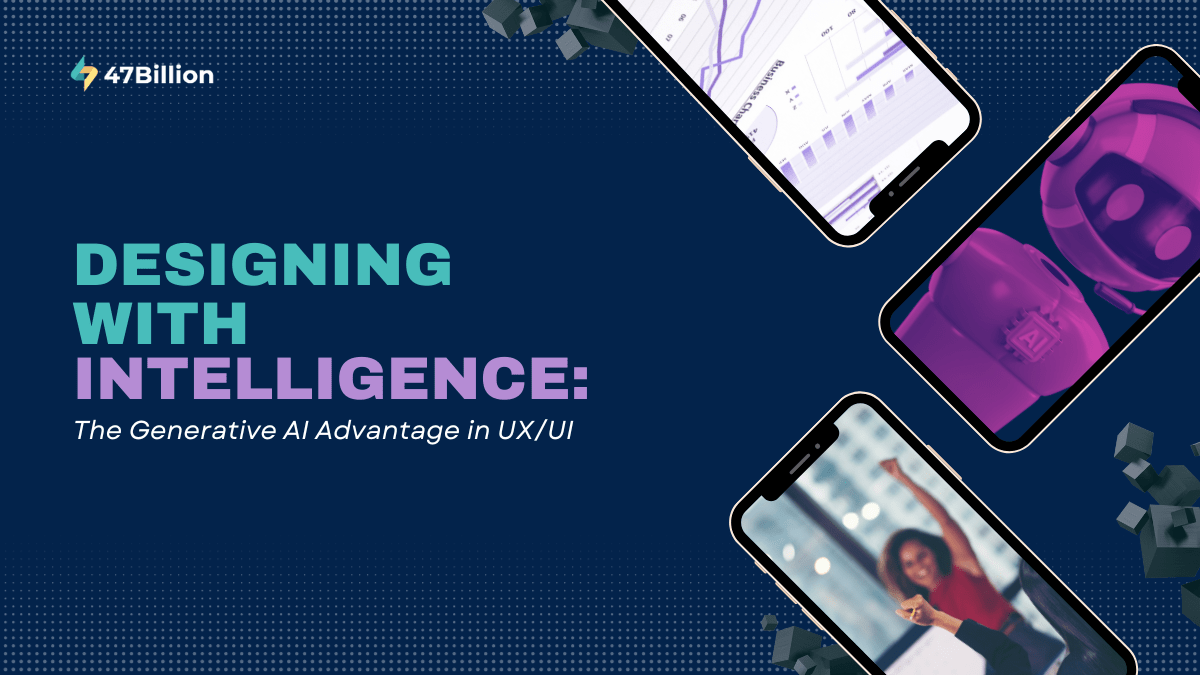As we enter the ever-evolving landscape, technological paradigm shifts have dramatically redefined how we interact with digital content. With the rise of the internet and GUI (Graphical User Interfaces) in digital devices and recently in voice-activated virtual assistants, there are significant changes in user experience and user interface.
Arguably, we are standing at the cusp of the next transformative phase in the history of computing, powered by generative AI’s potential to revolutionize the UX/UI design of digital products. By exploring how generative AI can help improve front-end design, let us delve into the game-changing impact it can have on the complete digital ecosystem.
Generative AI and how it is redefining UX/UI design
Generative AI is the AI model that learns from vast amounts of data and generates new, meaningful content resembling the original data. This could include images, text, or even music. These AI algorithms, such as generative adversarial networks and reinforcement learning models, are primed to be the driving force behind the next generation of digital experiences.
Revolutionizing User experience and design with Generative AI
The applications of generative AI in user experience and design are multifaceted and transformative. By integrating AI into the design process, developers and designers can create highly customized, efficient, and visually appealing interfaces that are more responsive to various user behaviors and preferences.
For example, AI-driven UI design tools can select and recommend the most relevant graphics, layouts, and design elements based on the user’s browsing history, content preferences, and personal taste. This not only streamlines the design process but also allows the creation of highly immersive digital experiences that resonate with users, fostering more engagement with personalization.
How is Generative AI acting as a helping hand?
Generative AI tools have made significant strides in user experience (UX) and design, enabling designers to automate specific tasks, generate creative assets, and even provide design suggestions. Here are some popular generative AI tools and techniques used in UX and design:
Adobe Sensei –
Adobe’s AI and machine learning platform are integrated into various Adobe Creative Cloud applications. It offers features like auto-tagging, smart cropping, and intelligent suggestions.
Runway M –
A creative toolkit that allows designers to experiment with a wide range of generative models. It supports models for image generation, style transfer, and more.
Designify –
It is a platform that uses AI to generate design recommendations for user interfaces. It can help with creating layouts, color schemes, and font choices.
Artbreeder –
A platform that allows users to blend and modify existing images, generating unique visuals. It’s often used for creating artwork, but it can be a source of inspiration for design elements.
Deep Art –
A tool that uses neural networks to apply artistic styles to images. It can be used to generate unique textures and patterns.
AutoDraw –
Google introduced it, a web-based tool that uses machine learning to predict what you’re trying to draw and offers suggestions in real time. It’s an excellent tool for quickly creating simple illustrations.
Designify (Framer) –
Framer’s Designify uses AI to analyze your designs and suggest improvements. It can help with layout, spacing, and alignment.
UI/UX Prototyping Tools with AI Features –
Some UI/UX prototyping tools like Sketch2React, Framer, and Adobe XD have started integrating AI-powered features to assist with design tasks.
Neural Style Transfer –
Techniques like neural style transfer use generative models to apply one image’s artistic style to another’s content, creating unique visuals.
Generative Adversarial Networks (GANs) –
GANs have been used in creative fields to generate images, animations, and music. They can be a powerful tool for generating unique design assets.
Userdoc –
Userdoc helps capture what product has to be built, its motivations and various user flows through the system – acting as a source of truth for requirements. It allows you to capture requirements in the discovery and scoping phases and refine them as the system evolves.
Marvin –
It automates the tedious parts of qualitative research so you can uncover rich insights about what your customers need.
The Potential Future Trends of Generative AI in UI/UX

In the coming years, AI will be instrumental in shaping the future of UI/UX design, driving innovation, enhancing personalization, and ultimately elevating the quality of digital experiences. Designers and AI developers must work collaboratively to harness AI’s potential and create user-centric, delightful, and responsible digital interfaces. The future of UI/UX design is bright, marked by continuous evolution and a commitment to enhancing our interaction with technology.
The trajectory of AI in UI/UX design is on a compelling path, holding the promise of transforming how we create and interact with digital experiences. As AI technologies continue to advance, the future of UI/UX design is poised for exciting possibilities:
1. Personalization: AI’s proficiency in processing vast amounts of user data will lead to personalized UI/UX experiences. Users will encounter interfaces tailored to their preferences, behaviors, and needs, fostering higher engagement and satisfaction.
2. Predictions-based Design: AI will become an indispensable design partner, predicting trends and user expectations. It will assist designers in proactively adapting interfaces to stay ahead of user demands, ultimately delivering more intuitive and delightful experiences.
4. Ethical AI Design: The industry will prioritize ethical and responsible design practices as AI assumes a more significant role. This includes addressing bias, ensuring privacy, and safeguarding data security, with guidelines and regulations crucial in shaping responsible AI design.
5. AI-Generated Content: AI-driven tools will excel in generating content, such as copy, graphics, and animations. This will challenge designers to transition from routine tasks to strategic decision-making, focusing on crafting cohesive user experiences.
6. Real-time Adaptation: AI algorithms will enable real-time adaptation of UI elements based on user interactions and changing contexts. Interfaces will become dynamic, ensuring seamless user journeys across various devices and scenarios.
7. Democratization of Design: AI-powered design tools will become more accessible, allowing individuals with varying design expertise to create professional-grade interfaces. This democratization will result in a proliferation of creative voices and innovative designs.
8. Cross-Platform Consistency: AI-driven design systems will ensure consistent user experiences across diverse platforms and devices. Users will enjoy familiarity and ease of use, regardless of whether they interact with an app on a smartphone, tablet, or desktop.
Conclusion
While Generative AI is undoubtedly transforming the UI/UX landscape, AI ruling the world seems far-fetched and dystopian. Instead, it should be viewed as a powerful tool that amplifies human creativity and ingenuity, enhancing how we design and interact with digital products.
The future of Generative AI in UI/UX will undoubtedly be exciting and filled with opportunities and challenges. To harness complete potential responsibly, designers must actively participate in its development, setting ethical guidelines and ensuring inclusivity and fairness. By embracing it as a partner rather than a competitor, the design community can leverage its capabilities to create innovative, user-centric, and delightful experiences for all.




